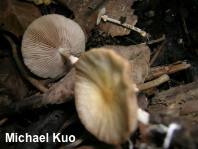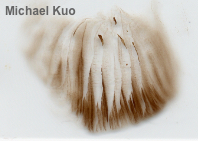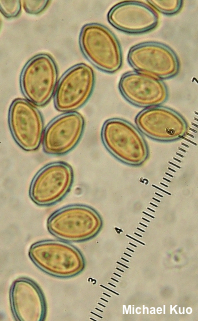| Major Groups > Gilled Mushrooms > Dark-Spored > Agrocybe & Cyclocybe > Agrocybe paludosa |

|
Agrocybe paludosa [ Basidiomycota > Agaricales > Strophariaceae > Agrocybe . . . ] by Michael Kuo Sixteen years ago I found this mushroom growing from the ground amid debris left by a nearby creek's spring flooding. I have not seen it again since, and that makes the fact that I hurried my collection especially irksome. I collected only a few mushrooms, even though there were plenty at hand, growing gregariously—and, worse, I fired off only a few quick photos that I later discovered were out of focus.Identifying features for Agrocybe paludosa include the slender stature (the fragile stem is usually under 4 mm thick), the persistent ring, the thin cap that develops a slightly lined margin, the brown spore print, and a preference for moist substrates (marshes, floodplain areas, and so on). Under the microscope it features sterile gill edges that are packed with primarily club-shaped cheilocystidia. Agrocybe praecox is very similar but stockier, with a stem often more than 1 cm thick. It appears in hardwood forests and, especially, in urban settings, among woodchips and in gardens. European sources (e.g. Nauta 2005, Ryman 2018) have begun to call this mushroom Agrocybe elatella, but I have been unable to locate sufficient and convincing documentation for the synonymy, and the major online nomenclatural databases do not agree on the correct current name for this species. Description: Ecology: Saprobic; growing alone, scattered, or gregariously from the ground in wet areas (marshes, spring run-off areas, etc.); appearing from spring through fall; fairly widely distributed in North America and in Europe. The illustrated and described collection is from Illinois. Cap: 2.5–4 cm; convex, becoming broadly convex or nearly flat; tacky when fresh, but soon dry; bald; tan to orangish tan, fading markedly as it dries out, to dirty buff; the margin grayish and finely lined. Gills: Narrowly attached to the stem or nearly free from it; close; short-gills frequent; whitish at first, becoming grayish brown; at first covered by a white partial veil. Stem: 4–7 cm long and 3 mm thick; more or less equal; fragile; bald; whitish, sometimes discoloring brownish, especially in the bottom half; with a high, white, skirtlike ring; base attached to white rhizomorphs. Flesh: Whitish; unchanging when sliced. Odor and Taste: Not distinctive. Chemical Reactions: KOH on cap surface negative to faintly gray. Spore Print: Medium brown. Microscopic Features: Spores 8–11 x 5–7 µm; more or less ellipsoid, with one end flattened for a 1–2 µm pore; smooth; thick-walled; dull yellowish brown in KOH. Basidia 26 x 7.5 µm; subclavate; 4-sterigmate. Cheilocystidia 30–40 x 10–20 µm; clavate; smooth; thin-walled; hyaline in KOH. Pleurocystidia similar to cheilocystidia. Pileipellis hymeniform; elements 10–25 µm across; pyriform; smooth; hyaline to yellowish in KOH. REFERENCES: (J. E. Lange, 1921) Kühner & Romagnesi, 1987. (Smith, Smith & Weber, 1979; Phillips, 1981; Moser, 1983; Hansen & Knudsen, 1992; Nauta, 2005; Buczacki et al., 2012; Ryman, 2018.) Herb. Kuo 08300402. This site contains no information about the edibility or toxicity of mushrooms. |
© MushroomExpert.Com |
|
Cite this page as: Kuo, M. (2020, December). Agrocybe paludosa. Retrieved from the MushroomExpert.Com Web site: http://www.mushroomexpert.com/agrocybe_paludosa.html |


